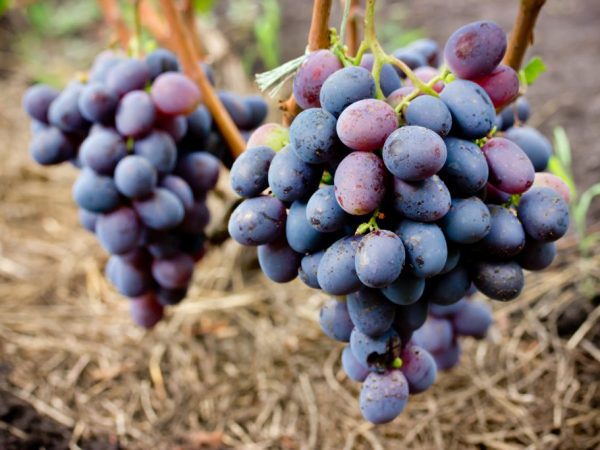Carmacode grape variety
The Karmakod grape appeared on the private plots of winegrowers relatively recently. It was obtained by breeding by crossing the elite Cardinal, Magarach and Codryanka. The consumer qualities of the berries of the plant are high, and therefore the seedlings of this hybrid are in demand.

Carmacode grape variety
Variety characteristic
Carmacode grapes are classified as table varieties. The main characteristics of the plant are:
- High yield: up to 1.5 kg of berries can be harvested from one shoot.
- Disease resistance. According to winegrowers, resistance to most diseases is about 4 points on a five-point scale.
- Frost resistance. Lianas can withstand soil frosts above 24 ° C.
- Self-pollination.
The Karmakod grape variety is classified as an early-ripening variety. The vine will give its first harvest in the third year of cultivation.
Description of bushes
According to the description of the Karmakod grape variety, the vines are medium-sized. A healthy vine is able to grow to the full growth of the shoot. To obtain a high yield, 10 eyes on a lash are enough, while the maximum number of ovaries on the whole plant cannot be more than 30.
Description of fruits
The grapes ripen in early August, after 120 days from the beginning of the growing season. They have a tart aftertaste with hints of musk and have a rich reddish hue. On the sunny side of the site, the berries can turn red-purple.
The mass of an average bunch reaches 500 g, while one berry weighs within 11 g. The shape of the bunch of Carmacode grapes is cylindrical, and the berries on them have an oblong-elongated shape. The sugar content in mature grapes reaches 23%, and the acid content is about 9 g per 1 liter. juice.
The fruits are used for fresh consumption, as well as for cooking:
- juices;
- dried fruits;
- jam;
- wine.
The features of the fruit include the ability to maintain quality during long-term storage and undemanding to the conditions of transportation.
The only drawback of Karmakod berries is their low resistance to frost and sensitivity to over-watering. In both the first and second cases, the grapes burst.
Growing grapes
Growing features

Growing grapes is not difficult
Growing grapes is not difficult. But, like all other thermophilic plants, the vine is highly susceptible to such factors:
- drafts;
- changes in the average daily temperature;
- small amount of light.
That is why the vine should be protected from all adverse factors. Particular attention should be paid to the neighborhood on the personal plot. Plants that also suffer from mildew and white rot, which lead to berry spoilage, are best located at a distant distance.
The most unfortunate places for growing grapes are lowlands and areas with a close occurrence of ground (fresh and salt) waters. The bad neighbors of the vine are fruit trees and fruit bushes.
In the southern regions, the vine is grown without a covering method. In areas with a more severe climate, a plant, especially one that has not reached the age of 5 years, needs to be covered for the winter.
Landing in the soil
Propagated grapes by cuttings. For this, the vine is harvested in the fall and stored in cellars. The shoots are planted in glasses or other covering containers. One leafy bud is left on each shoot.
The soil for germination of seedlings must contain:
- magnesium;
- nitrogen;
- potassium;
- phosphorus;
- calcium;
- iron.
The acidity of the soil does not matter. Rooted cuttings are planted in the ground in mid-May in the regions of the middle zone and at the end of April in the southern regions. The seedlings are transferred along with the lump of the substrate.
The transplant hole does not differ in composition from the soil for rooting. The bulk of the soil mixture should be humus and sod land. The space at the roots of the seedling is sown with green manure or mulch.
Plant care
Plant care consists in:
- timely and moderate watering;
- regular feeding;
- pruning and shaping creepers;
- preventive treatment of vines with insecticides and fungicides;
- shelter of young plants for the winter.
The lack of regular feeding and watering of the vines provokes the development of weak shoots that are not able to fight diseases and are exposed to the external environment.
The bush needs to be formed correctly, forming a four-arm fan with the length of the main shoots not exceeding 2 m.
Diseases and pests
The Karmakod grape vine is resistant to most fungal diseases, such as:
- mildew;
- oidium;
- gray rot.
The immunity of the Karmakod variety is significantly weakened with improper care and lack of prophylaxis.
To avoid the appearance of pests, the vine is treated with insecticides even before the leaves bloom. Twice a season, the plant is treated with Bordeaux liquid. If the summer is damp, the spraying is repeated every two weeks.
Conclusion
The cultivation of Karmakod grapes does not differ from the process of caring for other varieties. Grapes need feeding and moderate watering, as well as protection from drafts and cold winds.
Proper care of the vine allows you to get a crop of high quality and excellent presentation, because the fruits combine the best external and taste characteristics of the progenitors.


